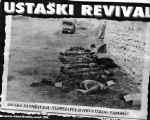 ABOUT BOSNIA ABOUT BOSNIA
BOZO JELIC
Kama and Tomorrow
 ertain historical and political circumstances, could have taught
us that it is much easier to turn a man into a pig, than to turn a pig into a man. ertain historical and political circumstances, could have taught
us that it is much easier to turn a man into a pig, than to turn a pig into a man.
There are men who write and recommend books for the nightmares of potential killers; they
know how to draw a higher ideals over a potential crime.
Most frequently, men kill in the name of a leader, state and nation, in the name of sacral
etatisme whose sunday tolling calls from time to time for a ritual killing, turning
seemingly week people into devil's children.
Only a few realized the fatal significance of those first announcements, a few who
understood that a publicly recommended crime would certainly be committed, in five, ten or
fifty years.
Bozo Jelic, an Ustasha from Siroki Brijeg, was a member of the so-called Devil's
Division in World War II, and a Wehrmacht soldier on the Eastern front; he was decorated
with an Iron Cross of the first and second order and greeted the German capitulation in
action: in the death camp JASENOVAC. Today, this 77-year-old sturdy man is photographed
for the Croatian papers: Nacional (03/01/96), in front of a wall on which his war
souvenir, a Kama [knife, used for butchering of people], is displayed. A rusty Kama under
the picture of Poglavnik (Croatian furer). This Kama looks as if it has been used (maybe
in Jasenovac) maybe frequently. A crooked blade of Kama as a political message, was
brought to its final conclusion in the paper published and edited by Pavelic's son in law,
Srecko Psenicnik (NDH), whose publication has recently begun in Zagreb. Under a photograph
of ten or so stiff dead bodies we can see a printed warning:

"This is how the enemies of the Croatian people will end up!".
As far as the message is concerned it doesn't really matter whether their throats had
been cut by Bozo Jelic or some other trustworthy Croat.
Nevertheless, if in todays Croatia it is possible to perform the coarsest possible
apology of crimes, then we should prepare for the future consequences of those
"democratic customs". How can we know whether Bozo Jelic or some other
trustworthy Croat, with a trophy Kama in his hand, will submit a protest because of
somebody's insufficient patriotism? Will he be hailed as a hero because of that? Since,
according to the Kama blade, used "in the name of the people and the state" and,
therefore, led by that huge and communal "us", the "real" Croats do
not butcher because of vices but because of highest ideals.
Before we turn our noses away from the latest photographic messages and head for the
Croatian democratic chaos, it is worth mentioning that Bozo Jelic and Nezavisna Drzava
Hrvatska have not appeared out of nowhere in our contemporary reality. They are simply the
most vulgar, totally unsophisticated pilgrims of the culture of killing which is today and
here cultivated as the state religion (or the religion of the state, whichever you
prefer). Its connotations are such that they can always (actually whenever necessary!)
turn up like blood on the ground. Because all "ideals" with which a crime has
been justified or recommended are in front of us; they are offered accompanied by a
beautiful tolling of the bells as the highest virtues of the cult: there is the Croatian
people, there is the Croatian state and their ever more numerous enemies.
How are we doing with Poglavnik?


Split, March 11, 1996
(text changed without permission of author)
2000, Community of Friends of Stolac |